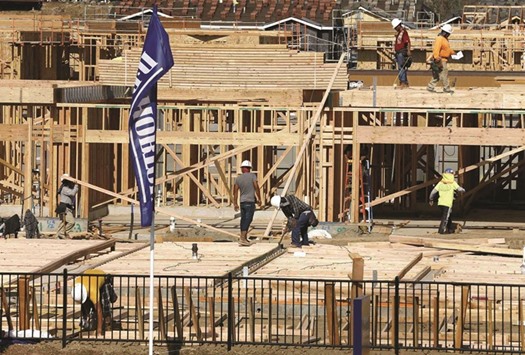US housing starts fell more than expected in March and permits for future home construction hit a one-year low, suggesting some cooling in the housing market in line with signs of a sharp slowdown in economic growth in the first quarter.
Yesterday’s report from the Commerce Department continued the recent run of weak data that has cast a pall on the economy’s prospects. Economists say the fragile economy, combined with tepid inflation vindicated the Federal Reserve’s cautious approach to raising interest rates.
“It’s not just American consumers stepping back a bit this year, homebuilders also lost steam,” said Sal Guatieri, a senior economist at BMO Capital Markets in Toronto.
“This means the two key drivers of the expansion have lost their pep, which explains why the Fed will probably lift rates, at most, a couple of times in 2016.”
Groundbreaking decreased 8.8% to a seasonally adjusted annual pace of 1.09mn units, the lowest level since October, the Commerce Department said. Economists polled by Reuters had forecast housing starts slipping to a 1.17mn-unit pace last month.
Last month’s drop in starts pointed to a moderation in housing market activity and mirrors other reports on business spending, industrial production, trade, inventory investment and retail sales that have suggested economic growth stalled in the first quarter.
The economy has been slammed by a strong dollar and weak global demand, which have weighed on exports. Lower oil prices are also a drag as they have undercut profits of energy firms, prompting them to sharply curtail spending on capital projects.
First-quarter gross domestic product growth estimates are currently as low as a 0.2% annualized rate. The economy grew at a 1.4% rate in the fourth quarter.
The PHLX housing index was down slightly, underperforming a broadly higher stock market that was buoyed by rising oil prices. Shares in the nation’s largest homebuilder DR Horton were down 0.95% and Lennar Corp slipped 0.84%.
The dollar fell against a basket of currencies and prices for US government debt were weak.
The Fed’s policy-setting committee meets on April 26-27. Market-based measures of expectations for Fed policy have priced out an interest rate hike in the first half of the year, according to CME Group’s FedWatch.
The Fed lifted its benchmark overnight interest rate in December for the first time in nearly a decade and policymakers recently forecast only two more rate hikes this year.
Despite the slump in groundbreaking activity last month, housing market fundamentals remain strong against the backdrop of a buoyant labour market, which is increasing employment opportunities for young adults, and in turn boosting household formation.
Single-family starts, the largest segment of the market, tumbled 9.2% to a 764,000-unit pace in March, the lowest since October, after touching a more than eight-year high in February.
They fell in all four regions last month, sliding 4.9% in the South, where most home building takes place.
Groundbreaking on multi-family housing projects declined 7.9% to a 325,000-unit pace. Starts for buildings with five units and more fell to their lowest level in a year.
“There is still a lot of supply being built, but industry reports finding rental vacancy rates coming off the lows and rent gains slowing appear to be leading builders to pull back,” said Ted Wieseman, an economist at Morgan Stanley in New York.
Building permits dropped 7.7% to a 1.09mn-unit rate last month, the lowest level since March last year.
Permits for the construction of single-family homes decreased 1.2% in March after scaling a more than eight-year high in February. Multi-family building permits plunged 18.6%, with approvals for buildings with five units or more falling to their lowest level since August 2013.

A home building project is seen in San Marcos, California. US housing starts fell more than expected in March and permits for future home construction hit a one-year low, suggesting some cooling in the housing market in line with signs of a sharp slowdown in economic growth in the first quarter.


